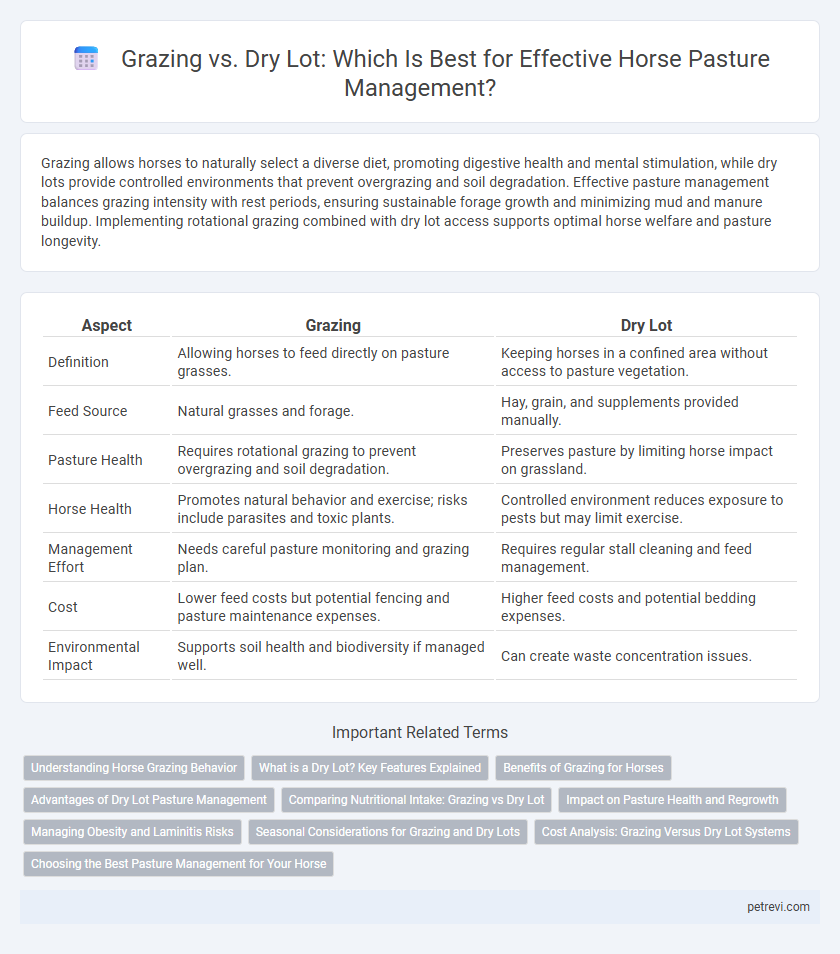Grazing allows horses to naturally select a diverse diet, promoting digestive health and mental stimulation, while dry lots provide controlled environments that prevent overgrazing and soil degradation. Effective pasture management balances grazing intensity with rest periods, ensuring sustainable forage growth and minimizing mud and manure buildup. Implementing rotational grazing combined with dry lot access supports optimal horse welfare and pasture longevity.
Table of Comparison
| Aspect | Grazing | Dry Lot |
|---|---|---|
| Definition | Allowing horses to feed directly on pasture grasses. | Keeping horses in a confined area without access to pasture vegetation. |
| Feed Source | Natural grasses and forage. | Hay, grain, and supplements provided manually. |
| Pasture Health | Requires rotational grazing to prevent overgrazing and soil degradation. | Preserves pasture by limiting horse impact on grassland. |
| Horse Health | Promotes natural behavior and exercise; risks include parasites and toxic plants. | Controlled environment reduces exposure to pests but may limit exercise. |
| Management Effort | Needs careful pasture monitoring and grazing plan. | Requires regular stall cleaning and feed management. |
| Cost | Lower feed costs but potential fencing and pasture maintenance expenses. | Higher feed costs and potential bedding expenses. |
| Environmental Impact | Supports soil health and biodiversity if managed well. | Can create waste concentration issues. |
Understanding Horse Grazing Behavior
Horse grazing behavior is characterized by selective grazing, preferring short, young pasture growth, which influences pasture regrowth and overall forage availability. In grazing systems, horses typically consume forage for 16 to 18 hours daily, requiring careful rotational grazing to prevent overgrazing and maintain pasture health. Dry lot management limits grazing time, reducing pasture strain but necessitates supplemental feeding and increased manure management to support horse nutrition and environmental sustainability.
What is a Dry Lot? Key Features Explained
A dry lot is a designated, non-grassy area used in horse pasture management to control grazing and prevent overuse of pastureland. Key features include a durable surface, such as gravel or dirt, fenced boundaries, and access to water and shelter, which help maintain horse health by limiting excessive forage intake and foot health issues. Dry lots facilitate rotational grazing and provide a safe space during adverse weather or pasture recovery periods.
Benefits of Grazing for Horses
Grazing allows horses to access fresh, nutrient-rich forage, promoting natural digestive function and improved gut health. Continuous access to pasture reduces the risk of colic and supports mental well-being through natural foraging behavior. Properly managed grazing also provides exercise opportunities, aiding in muscle tone and weight maintenance.
Advantages of Dry Lot Pasture Management
Dry lot pasture management offers precise control over a horse's diet, reducing the risk of overgrazing and promoting pasture sustainability. It helps prevent soil erosion and reduces the spread of parasites commonly found in wet or overgrazed fields. This method ensures consistent hoof health by providing a dry, clean environment while facilitating easier manure management and pasture maintenance.
Comparing Nutritional Intake: Grazing vs Dry Lot
Grazing provides horses with a diverse range of nutrients from fresh forage, including essential vitamins, minerals, and fiber that promote digestive health and natural feeding behavior. In contrast, a dry lot limits access to fresh grass, requiring supplemental feeding with hay and concentrates to meet nutritional needs, which may lack certain micronutrients found in pasture. Proper management of both systems involves careful balancing of nutrient intake to prevent deficiencies or overfeeding, ensuring optimal equine health and performance.
Impact on Pasture Health and Regrowth
Grazing horses on pasture promotes natural grass regrowth by allowing plants to photosynthesize and recover between grazing periods, maintaining root depth and soil structure essential for pasture health. In contrast, dry lot feeding concentrates manure and can lead to soil compaction and nutrient imbalances, hindering pasture regrowth when horses return to grazing areas. Managing stocking rates and rotational grazing enhances pasture resilience, optimizing nutrient cycling and minimizing overgrazing impacts.
Managing Obesity and Laminitis Risks
Grazing management significantly impacts equine health by regulating energy intake and minimizing obesity and laminitis risks associated with lush pasture consumption. Dry lot systems provide controlled feeding environments that prevent excessive caloric intake and allow for precise monitoring of horses prone to metabolic disorders. Implementing rotational grazing coupled with dry lot periods optimizes forage availability while reducing the incidence of obesity-related laminitis in horses.
Seasonal Considerations for Grazing and Dry Lots
Seasonal variations significantly impact horse pasture management, with grazing being more feasible in spring and fall when grass growth is optimal, providing essential nutrients for horses. Dry lots are preferable during winter and drought conditions to prevent overgrazing and pasture damage while ensuring horses have consistent access to hay and water. Managing pasture rotation based on seasonal growth patterns helps maintain pasture health and supports equine well-being throughout the year.
Cost Analysis: Grazing Versus Dry Lot Systems
Grazing systems typically incur lower feed costs due to natural forage consumption, reducing reliance on purchased hay and supplements, whereas dry lot systems demand higher expenses for feed and bedding. Maintenance costs for grazing involve pasture management activities such as fertilization, reseeding, and fencing repairs, while dry lot requires frequent manure removal and stall upkeep. Investment in land quality and infrastructure varies: grazing necessitates sufficient acreage with nutrient-rich grasses, whereas dry lot systems require durable surfaces and shelter, influencing overall cost-effectiveness in horse pasture management.
Choosing the Best Pasture Management for Your Horse
Choosing the best pasture management for your horse involves weighing the benefits of grazing versus dry lot systems, with grazing providing natural forage that supports digestive health and mental well-being. Grazing systems require regular pasture rotation to prevent overgrazing and maintain nutrient-rich grass, while dry lots offer controlled feeding environments reducing parasite loads and soil degradation. Optimal pasture management balances forage availability, horse health, and land sustainability to ensure long-term productivity and animal welfare.
Grazing vs Dry Lot for Horse Pasture Management Infographic

 petrevi.com
petrevi.com